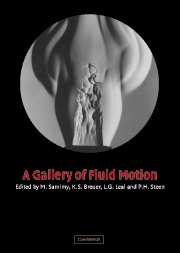4 - Drops and bubbles
Published online by Cambridge University Press: 25 January 2010
Summary
The collision of a droplet with a solid surface
The photographs displayed above show the impact, spreading, and boiling history of n-heptane droplets on a stainless steel surface. The impact velocity, Weber number, and initial droplet diameter are constant (values of 1 m/s, 43 and 1.5 mm respectively), and the view is looking down on the surface at an angle of about 30°. The photographs were taken using a spark flash method and the flash duration was 0.5 μs. The dynamic behavior illustrated in the photographs is a consequence of varying the initial surface temperature.
The effect of surface temperature on droplet shape may be seen by reading across any row; the evolution of droplet shape at various temperatures may be seen by reading down any column. An entrapped air bubble can be seen in the drop when the surface temperature is 24°C. At higher temperatures vigorous bubbling, rather like that of a droplet sizzling on a frying pan, is seen (the boiling point of n-heptane is 98°C) but the bubbles disappear as the Leidenfrost temperature of n-heptane (about 200°C) is exceeded because the droplet become levitated above a cushion of its own vapor and does not make direct contact with the surface. The droplet shape is unaffected by surface temperature in the early stage of the impact process (t≤0.8 ms) but is affected by temperature at later time (cf. t≥ 1.6 ms) because of the progressive influence of intermittent solid-liquid contact as temperature is increased.
- Type
- Chapter
- Information
- A Gallery of Fluid Motion , pp. 42 - 53Publisher: Cambridge University PressPrint publication year: 2004



